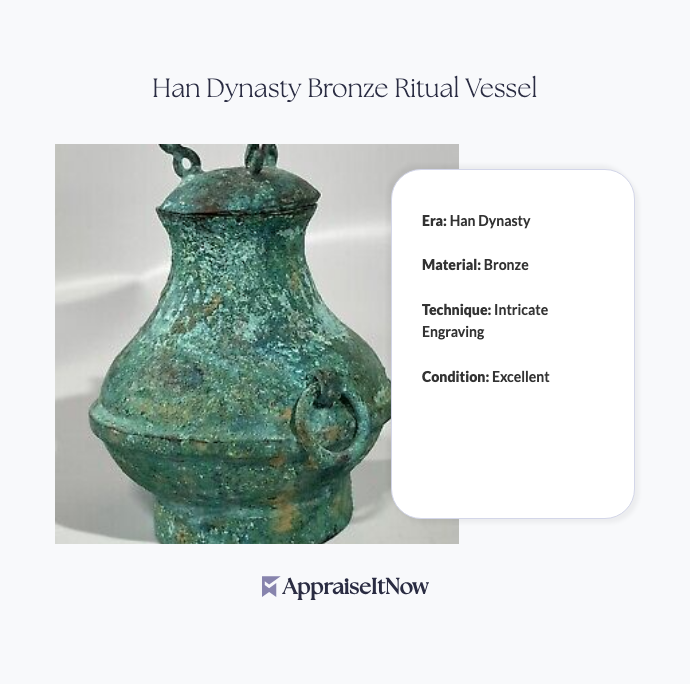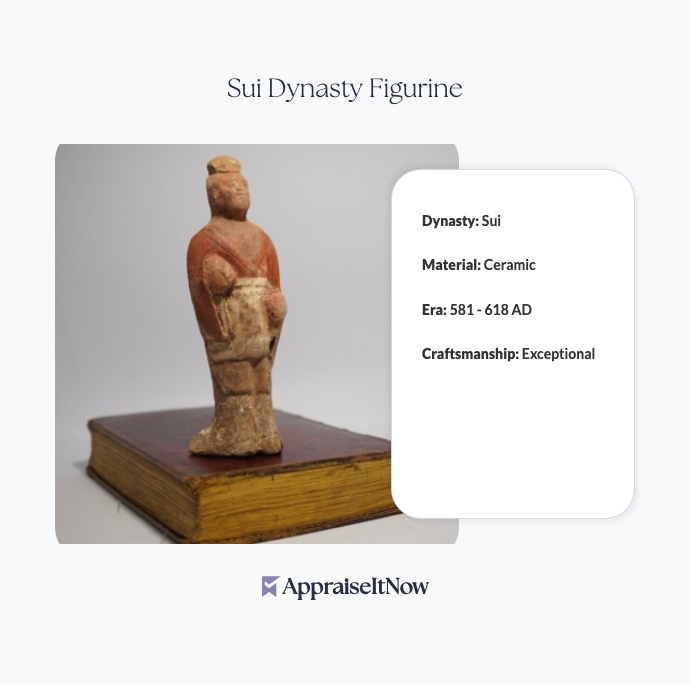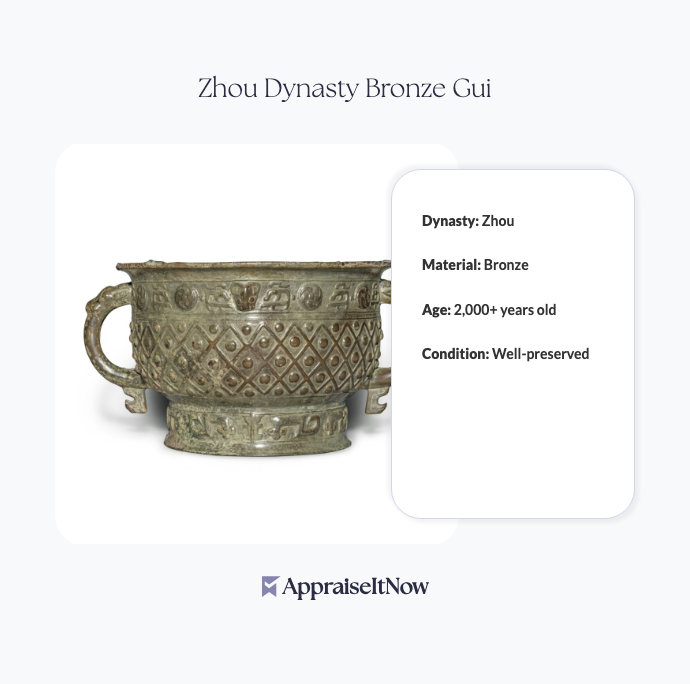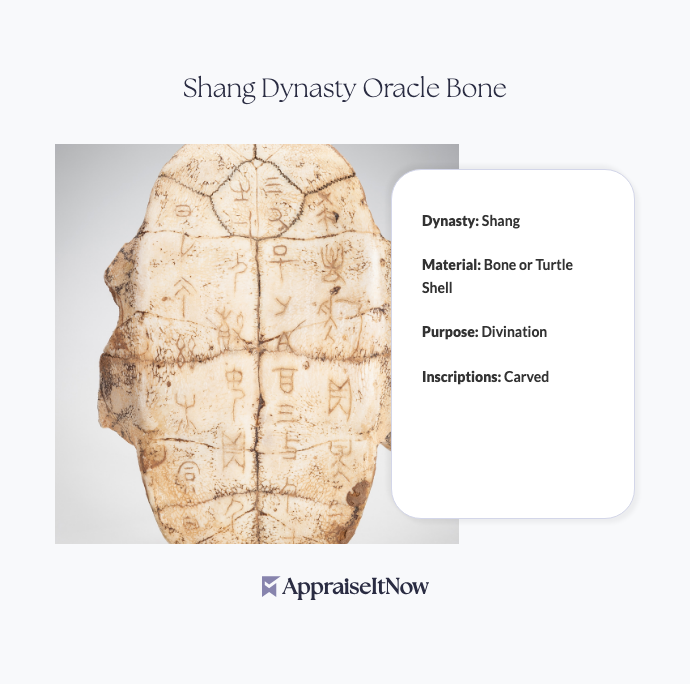<h1>How to Get Your Han Dynasty Bronze Ritual Vessel Appraised</h1>
<p>If you own or are considering acquiring a Han Dynasty bronze ritual vessel, understanding its true value requires more than just a quick internet search. These exquisite artifacts command significant prices—typically between <strong>$30,000 and $40,000</strong> for quality examples—but arriving at an accurate appraisal involves specialized knowledge of ancient Chinese metalworking, historical provenance, and current market dynamics. A professional appraisal from a credentialed expert ensures you have the documentation and confidence necessary for buying, selling, or insurance purposes.</p>
<h2>Understanding Han Dynasty Bronze Ritual Vessels</h2>
<p>Han Dynasty bronze ritual vessels represent some of the finest achievements in ancient Chinese metallurgy. Crafted between <strong>206 BC and 220 AD</strong>, these vessels showcase extraordinary technical mastery and artistic sophistication that continues to captivate collectors today. Your piece likely functioned in religious ceremonies or graced imperial court collections, roles that significantly enhance its historical and monetary value.</p>
<p>What makes these vessels so valuable? The combination of exceptional artistry, impressive size and weight, and the advanced metalworking techniques required to create them. Unlike many ancient artifacts that survive in fragmentary condition, well-preserved ritual vessels provide a tangible connection to China's imperial heritage. When considering acquiring or selling these pieces, understanding what distinguishes a museum-quality example from a lesser specimen becomes essential to making informed decisions.</p>
<div class="callout tip"><p><strong>Collector's Insight</strong></p>
<p>Han Dynasty ritual vessels with excellent provenance—documented ownership chains and clear acquisition history—typically command 15-25% premiums over examples lacking detailed background.</p></div>
<h2>Key Features That Determine Appraisal Value</h2>
<p>Several technical and historical factors directly influence how appraisers establish your Han Dynasty bronze vessel's worth. First produced during the Han Dynasty around <strong>206 BC</strong>, these ritual vessels represent a specific moment in Chinese artistic and technological development. The vessel you're evaluating exists within a marketplace where condition, provenance, size, and historical significance determine its position within that <strong>$30,000-$40,000</strong> range.</p>
<p><strong>Condition and material integrity</strong> form the foundation of any appraisal. Professional appraisers examine surface patina, structural soundness, and any evidence of repair or restoration. Original, untouched patina—even with some discoloration—often commands premiums over aggressively cleaned examples. The vessel's weight and dimensions also matter considerably; larger, more substantial pieces with impressive proportions typically appraise higher than smaller examples, as they demonstrate greater material investment and technical mastery.</p>
<p><strong>Design complexity and iconography</strong> significantly affect valuation. Ritual vessels featuring intricate designs, religious symbols, or imperial insignia that scholars can identify and contextualize within Han Dynasty artistic traditions command higher values. The engraved or cast symbols on your vessel's surface tell stories about its original purpose and the artisans who created it. When you understand these design elements through professional analysis, you gain insight into why certain vessels attract serious collectors and museums.</p>
<div class="callout note"><p><strong>Authentication Consideration</strong></p>
<p>Given the market for high-value Asian antiques, professional appraisers verify authenticity through metallurgical analysis, design period comparison, and examination of manufacturing techniques specific to Han Dynasty production methods.</p></div>
<h2>How to Identify Valuable Chinese Antiques</h2>
<p>If you're wondering how to determine whether your Chinese vase or ritual vessel has significant value, several key indicators provide guidance before investing in professional appraisal services. Vessels designed for imperial court use carry substantially higher values than those produced for everyday ritual purposes. The quality of the bronze casting, surface decoration technique, and overall artistic achievement all signal whether you're holding a museum-quality piece or a more modest historical artifact.</p>
<p>Size and presence matter considerably. Larger ritual vessels with impressive dimensional presence and substantial weight typically appraise higher than smaller examples. When examining your piece, notice whether the bronze shows evidence of careful casting and refined surface treatment—hallmarks of court-commissioned work versus production for wider distribution. Vessels with rare or particularly significant symbolism, especially those representing specific deities or incorporating auspicious imperial symbols, attract particular collector interest.</p>
<p>The question of what constitutes valuable Chinese pottery marks often arises among collectors. Maker's marks, imperial seals, or potter's signatures can significantly enhance appraisal value, particularly when these marks can be definitively attributed to known artisans or specific imperial workshops. However, for bronze ritual vessels, the overall artistic merit and historical context typically matter more than maker identification, since many ancient bronzeworkers remain anonymous despite creating masterpieces.</p>
<h2>Establishing Provenance and Documentation</h2>
<p>Your Han Dynasty bronze ritual vessel's value partly depends on its documented history—what collectors and appraisers call "provenance." This means having clear records of who owned the piece, where it came from, and how it traveled from ancient China to your collection. Pieces with established provenance from respected museums, noted collectors, or recognized antiquities dealers command substantially higher values than examples without documented history.</p>
<p>When preparing for appraisal, compile any available documentation: auction house catalogs if you acquired it at sale, certificates of authenticity, previous appraisals, insurance documents, or correspondence with dealers or experts. Professional appraisers specializing in <a href="/blog/appraising-asian-art-and-antiques-understanding-cultural-significance-and-value">Asian art and antiques</a> understand how to integrate this documentation into a comprehensive valuation that accounts for historical context and current market conditions.</p>
<p>If you're wondering how to find out whether your vessel is actually worth money and not merely a reproduction or lesser piece, professional appraisal provides definitive answers. Experts examine manufacturing techniques, material composition, patina characteristics, and design elements to distinguish authentic Han Dynasty bronzes from later imitations or pieces from nearby historical periods. This authentication process directly impacts appraisal value, as collectors and institutions require confidence in authenticity before committing significant resources.</p>
<h2>Dating Bronze Vessels and Assessing Authenticity</h2>
<p>How can you date a bronze vessel to confirm its Han Dynasty origins? Professional appraisers employ multiple methods to establish chronology with confidence. Design analysis comparing your vessel's style to known examples from specific Han Dynasty periods represents one crucial technique. Bronze vessels produced during different eras display recognizable stylistic evolution—changes in handle design, decoration patterns, and functional features that experienced appraisers quickly identify.</p>
<p>Metallurgical analysis provides scientific confirmation of dating and authenticity. The trace elements present in ancient bronze, the casting method employed, and any evidence of ancient repair or modification tell stories about the piece's true age and origin. Appraisers may examine X-rays or conduct non-destructive testing to assess internal structure without damaging the vessel. For <a href="/blog/appraising-artifacts-and-antiquities-evaluating-historical-finds">artifacts and antiquities</a>, these scientific approaches complement art historical analysis to build comprehensive authentication cases.</p>
<p>The condition of patina also signals authenticity. Genuine Han Dynasty bronze develops specific patina characteristics over two millennia—patterns that modern patination techniques struggle to accurately replicate. Experienced appraisers recognize these subtle signs of age, understanding that centuries of oxidation, soil contact, and environmental exposure create distinctive surface characteristics that forgeries rarely achieve convincingly.</p>
<div class="callout tip"><p><strong>Preservation Note</strong></p>
<p>Avoid aggressive cleaning or restoration of your Han Dynasty bronze vessel. The patina that might seem unsightly actually provides important evidence of authenticity and can significantly impact appraisal value.</p></div>
<h2>The Role of Ritual Vessel Function in Valuation</h2>
<p>What are ritual vessels, exactly? These bronzes served specific ceremonial purposes in ancient Chinese religion and imperial practice. Some held sacrificial offerings to deities or ancestors, while others functioned as status symbols displaying imperial power and refined taste. Understanding your vessel's likely original function—whether it held liquids, stored ceremonial items, or served purely symbolic purposes—contributes valuable context to appraisals.</p>
<p>Vessels with clearly identifiable ritual purposes and strong historical documentation of use command premium values. A bronze vessel that scholars can confidently identify as having adorned a specific imperial temple or served a particular ceremonial function carries greater prestige and collector appeal than a piece whose original context remains uncertain. This contextual knowledge often makes the difference between a $30,000 appraisal and one approaching $40,000 for similar-sized pieces.</p>
<h2>Market Dynamics and Current Collecting Trends</h2>
<p>The Han Dynasty bronze ritual vessel market has remained relatively stable, with consistent demand from serious collectors, institutional buyers, and museums. Unlike some antique markets subject to rapid fluctuations, these ancient bronzes represent enduring value based on their historical significance, artistic merit, and the finite supply of authenticated examples.</p>
<p>Current market demand reflects several factors: growing appreciation for Chinese cultural heritage among international collectors, increasing institutional acquisition efforts by major museums, and stable pricing as these vessels transfer between established collectors. When you're considering selling your piece, understanding these market dynamics helps you time the transaction appropriately and establish realistic expectations. Professional appraisers track these market trends and can contextualize your specific vessel within current pricing patterns.</p>
<h2>Choosing a Qualified Appraiser for Your Bronze Vessel</h2>
<p>Selecting the right appraiser significantly impacts the quality and credibility of your Han Dynasty bronze ritual vessel's valuation. You want expertise in ancient Chinese metalwork, understanding of Han Dynasty artistic and technical traditions, and familiarity with current market values. Look for appraisers with credentials from recognized professional organizations—the <strong>Appraisers Association of America (AAA)</strong>, <strong>American Society of Appraisers (ASA)</strong>, or <strong>International Society of Appraisers (ISA)</strong> indicate professional standing and commitment to ethical standards.</p>
<p>Your appraiser should possess specific experience with <a href="/types/antique-artwork">antique artwork</a> and <a href="/types/antiques">Asian artifacts</a> rather than general merchandise valuation. When interviewing potential appraisers, ask about their experience with Han Dynasty bronzes specifically, their methodology for establishing market values, and their familiarity with comparable recent sales. A qualified expert can explain exactly how they arrive at your piece's valuation and provide detailed documentation suitable for insurance, sale, or estate purposes.</p>
<p><strong>AppraiseItNow</strong> connects you with certified appraisers across the United States who specialize in ancient Asian art and artifacts. Our experts provide <strong>USPAP-compliant valuations</strong>—reports meeting the Uniform Standards of Professional Appraisal Practice—ensuring your documentation withstands professional and legal scrutiny. Whether you need appraisal for insurance replacement value, equitable division in estate settlements, or sale preparation, professional expertise provides confidence and credibility.</p>
<h2>Preparing Your Vessel for Appraisal</h2>
<p>Before scheduling an appraisal appointment, prepare your Han Dynasty bronze ritual vessel appropriately. Photograph it from multiple angles in natural light, capturing any inscriptions, surface markings, or distinctive design elements. Compile all available documentation about acquisition, previous appraisals, or historical information about the piece. Clean the vessel gently with soft materials if it bears dust or debris, but avoid aggressive cleaning that might damage original patina or surface details.</p>
<p>When the appraiser arrives, ensure adequate lighting for detailed examination. Allow sufficient time for thorough inspection, measurement, and documentation. Share any information you possess about the piece's history, though experienced appraisers will form independent conclusions based on physical evidence. The appraisal process for <a href="/blog/appraising-fine-bronze-sculptures-valuing-metal-artistic-creations">fine bronze sculptures</a> and ancient ritual vessels typically requires 1-3 hours, depending on condition and complexity.</p>
<h2>Understanding Appraisal Reports and Valuations</h2>
<p>Your completed appraisal report should provide clear documentation of the Han Dynasty bronze ritual vessel's estimated value, typically presented as a range reflecting market uncertainty. The <strong>$30,000-$40,000</strong> valuation represents fair market value—the price at which the piece would transfer between informed buyers and sellers with adequate time for marketing and negotiation. The report should explain the appraiser's methodology, describe the vessel's condition and significant features, and provide context for the valuation within the broader market.</p>
<p>Professional reports include high-quality photographs, detailed condition descriptions, and comparative analysis of similar pieces that have sold recently. This documentation becomes essential if you need to support insurance claims, establish values for tax purposes, or document the piece during estate planning. Understanding what appraisers look for when evaluating your Han Dynasty bronze helps you appreciate the expertise that goes into establishing accurate, defensible valuations.</p>
<div class="callout note"><p><strong>Key Takeaway</strong></p>
<p>A certified appraisal of your Han Dynasty bronze ritual vessel provides authoritative valuation, comprehensive documentation, and professional expertise that translates historical significance and artistic merit into clear monetary value—essential whether you're buying, selling, insuring, or preserving this remarkable artifact for future generations.</p></div>







.avif)







